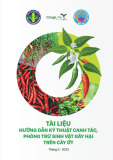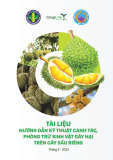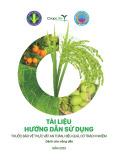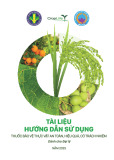
Int.J.Curr.Microbiol.App.Sci (2020) 9(4): 525-532
525
Original Research Article https://doi.org/10.20546/ijcmas.2020.904.063
Hematological Alterations in Cisplatin Induced Toxicity in Rats and Its
Amelioration by Andrographis paniculata
T. Rajendrakumar1*, Suguna Rao1, M. L. Satyanarayana1,
H. D. Narayanaswamy1, S. M. Byregowda2 and N. B. Shridhar3
1Department of Veterinary Pathology, Veterinary College, KVAFSU, Hebbal,
Bangalore-560024, India
2Institute of Animal Health and Veterinary Biologicals, KVAFSU, Bangalore, India
3Department of Veterinary Pharmacology, Veterinary College, Vinobanagar,
Shimogga-577204, India
*Corresponding author
A B S T R A C T
Introduction
Cisplatin (CP) is a chemotherapeutic agent
widely used in the treatment of several types
of cancer including leukemia, lymphoma,
sarcoma, cancer of lung, mammary gland and
ovary (Hemati et al., 2012). Cisplatin is one
of alkylating agents that directly damage
DNA resulting in cell apoptosis. Like most of
chemotherapeutic drugs; cisplatin does not
distinguish between cancer and normal cells
and eliminates not only the fast-growing
cancer cells but also other fast-growing cells
in the body (Abdel et al., 2012). The
oxidative stress through formation of the free
radicals is also one of the mechanisms of
International Journal of Current Microbiology and Applied Sciences
ISSN: 2319-7706 Volume 9 Number 4 (2020)
Journal homepage: http://www.ijcmas.com
Cisplatin (CP) is considered one of the most effective and widely used anti-neoplastic drug
in the treatment of different solid organ tumors. The present study was carried out to assess
the hematological changes following CP administration in Wistar albino rats and its
amelioration by extract of Andrographis paniculata (AP). The study included 60 Wistar
albino rats were divided into 12 rats in each group. Group I served as normal control
group. To group II rats, CP was administered at 7.5mg/kg body weight intraperitoneally
for single dose. Rats in group III were administered AP at the dose of 500mg/kg body
weight for 45 days. Group IV rats were pre-treated with AP 15 days prior to CP
administration and followed by AP treatment for 45 days. Rats in group V were
administered with CP and concurrently treated with AP extract at 500mg/kg by oral
gavaging for 45 days. The CP treated rats showed significant decrease in haemoglobin,
TEC, TLC and platelet count as compared to normal control animals. Supplementation of
AP to CP treated rats significantly improved the hematological parameters. The study
concluded that damage to the hemopoietic system evident by deranged hematological
parameters can be prevented by administration of extract of Andrographis paniculata.
Keywords
Andrographis
paniculata, Wistar
Albino rats,
Hematological
parameters
Accepted:
07 March 2020
Available Online:
10 April 2020
Article Info

Int.J.Curr.Microbiol.App.Sci (2020) 9(4): 525-532
526
cisplatin induced toxicity. Treatment with
cisplatin frequently causes nephrotoxicity,
hepatotoxicity, thrombocytopenia and bone
marrow toxicity (Shalaby et al., 2014). To
ameliorate the toxic effects of CP without
inhibiting its anti-tumor effects, different
experimental studies were carried out using
combination of CP with radicular scavengers,
antioxidants and natural foods with
antioxidant properties (Iseri et al., 2007).
Andrographis paniculata (AP) is an important
drug of Indian Systems of Medicine (ISM)
and used in medicines. The AP identified as
Hemedu Bumi and generally known as King
of Bitter and cultivated in the tropical areas of
India, China and South East Asia (Trivedi and
Rawal, 2001). Andrographis paniculata was
reported to possess antimicrobial, antiviral,
antimalarial hepatoprotective, antioxidant,
antidiabetic, antihyperglycemic, anti-diarrheal
and anti-inflammatory and immuno-
modulatory effects (Akbar, 2011).
Phytochemical analysis has revealed that it is
a rich source of diterpenoids and 2
oxygenated flavonoids including andro-
grapholide, neoandrographalide, isoandro-
graphalide, andrographan- andrographosterin
and stigmasterol (Bardi et al., 2014).
Considering the above beneficial properties of
AP, the present study was undertaken to
evaluate the efficacy of Andrographis
paniculata in ameliorating the toxic effects
cisplatin on the hematopoietic system in
Wistar albino rats.
Materials and Methods
Drugs and chemicals: Cisplatin (Kemoplat)
was procured from Fresenius Kabi India Pvt.
Ltd. Pune, India. and the ethanolic extract of
Andrographis paniculata was obtained from
Himalaya Herbal Pvt Ltd. Bangalore, India
Animals: Normal adult Wistar albino rats
weighing approximately 180-200 grams were
procured from commercial animal facility,
Bangalore for the study. They were
maintained under standard laboratory
conditions and fed with ad libitum standard
commercial rat feed and clean drinking water.
The duration of experiment was for a period
of 45 days and a prior permission was
obtained from the Institutional Animal Ethics
Committee (IAEC) for the conduct of the
experiment.
Experimental design: The rats were
maintained under standard laboratory
conditions for a period of 15 days for
acclimatization in the experimental animal
house. The rats were divided, based on the
body weight, into five groups with twelve rats
in each group.
Group I: Normal control-injected with 0.5ml
sterile PBS intraperitoneally on Day 1 and
gavaged with PBS daily.
Group II: Positive control- toxicity induced
with administration of cisplatin at 7.5mg/kg
body weight intraperitoneally for single dose.
Group III: Supplemented with ethanolic
extract of Andrographis paniculata alone at
the dose rate of 500 mg/kg body weight.
Group IV: Supplemented with Andrographis
paniculata extract at the dose rate of
500mg/kg bodyweight15 days prior to
induction of toxicity by CP.
Group V: Supplemented with Andrographis
paniculata extract at the dose rate of
500mg/kg body weight concurrently with
administration of CP.
Experimental induction of toxicity in rats
To induce toxicity, the rats were fasted
overnight and injected with cisplatin (CP)
7.5mg/kg body weight by intraperitoneal

Int.J.Curr.Microbiol.App.Sci (2020) 9(4): 525-532
527
routeas a single dose. The negative control
animals were injected intraperitoneally with
PBS alone. The rats in Group III were
supplemented with extract of Andrographis
paniculata at 500 mg/kg body weight alone
for 45 days. The rats in Group IV were
supplemented with extract of Andrographis
paniculata at 500 mg/kg body weight, by oral
gavaging, 15 days prior to and for 45 days
following induction of toxicity with cisplatin
(CP).The rats in Group V were supplemented
with extract of Andrographis paniculata at
500 mg/kg body weight, intraperitoneally for
45days along with methotrexate at the rate of
7.5mg/kg bodyweight by intraperitoneal route
for single dose.
Hematological parameters
On the scheduled days of blood collection
(7th, 14th, 28thand45th day of the experiment),
few drops of blood was collected from the
retro-orbital flexus, in a vial containing
ethylene diamine tetra acetic acid (EDTA) as
an anticoagulant for evaluation of
hematological parameters such as total
erythrocyte count (TEC), total leukocyte
count (TLC), total platelet count and
hemoglobin (Hb). For the hematological
evaluation, the auto hematology analyzer
(BC-2800 VET, Mindray), was used.
Results and Discussion
The effect of CP administration on the
hematological parameters was analyzed. The
results indicated that CP caused a significant
decrease(P<0.05) in the levels of hemoglobin,
TEC, TLC and total platelet count (Table 1, 2,
3, 4 and Figure 1, 2, 3, 4) in the Group-II
when compared to normal control animals
throughout the duration of the experiment.
Similar observations in the blood parameters
following cisplatin administration have also
been reported by Ramya et al., (2013); Nasr
(2014); Divya et al., (2016); Karale and
Kamath (2017); Shaymaa et al., (2017); Song
et al., (2017); Bhachand raet al.(2018) and
Lin et al., (2018). Cisplatin is one of the most
potent cytotoxic agents, is reported to cause
toxic side effects on different body organs
such as hepatotoxicity, nephrotoxicity and
bone marrow suppression.
Hematopoietic system is one of the most
sensitive systems to evaluate the hazards
effects of poisons and drugs in humans and
animals (Lijuv et al., 2013).
Chemotherapeutic drugs are usually cytotoxic
which results in the killing cancer of cells
although, unfortunately, the immune system is
destroyed at the same time. Depending upon
the proliferating nature, bone marrow cells are
very sensitive to cytotoxic chemicals and
easily susceptible to DNA damage especially
undifferentiated population (Shaymaa et al.,
2017). Inhibition of cell proliferation is one of
the major causes of cisplatin induced
myelotoxicity (Basu et al., 2015). The
reduction in these values in the present study
might be due the effect of cisplatin on bone
marrow.
There was an etiological relationship between
anemia and CP treatment. Such relationship
could be explained through different
mechanisms including destruction of bone
marrow cells or increase osmotic fragility of
RBCs. Thus, CP intoxication might lead to
anemia as a result of either suppression the
activity of hematopoietic tissues, impaired
erythropoiesis, and accelerated RBCs
destruction because of the altered RBCs
membrane permeability (Hassan et al., 2010).
Nowis et al., (2007) reported that cisplatin
administration reduced erythropoietin, a
haemopoietic growth factor, which further
resulted in alteration of hematological
parameters. Olas et al., (2005) showed that
CP causes oxidative stress in human platelets
and lymphocytes, which might reflect on their
life expectancy, the induction of apoptosis,

Int.J.Curr.Microbiol.App.Sci (2020) 9(4): 525-532
528
and thereby ultimately reduce the number of
these cells in the blood. Markovic et al.,
(2011) suggested that, aside from reduction in
the RBC number, decrease in platelets count
might be due to CP inhibiting bone marrow
activity or could be due to decreased
production or increased consumption of
platelets or due to the increased platelets
aggregation. The previous results suggest that
thrombocytopenia and leukopenia in cisplatin
treated group were resulted from apoptotic
effect of cisplatin on lymphocytes and
platelets thereby ultimately reduced the
number of these cells in the blood (Shymaa et
al., 2017). In addition, bleeding due to
intestinal affections by cisplatin and free
radical induced red cell damage could be
contributory for lesser erythrocyte count and
hemoglobin values.
Table.1 The mean (±SE) values of hemoglobin (g %) of different groups at different time
intervals
Groups
Days of post treatment
07th
14th
28th
45th
GP-I
13.4±0.258ax
13.6±0.155dax
14.4±0.15ay
13.76±0.11axy
GP-II
8.15±0.11bx
8.50±0.155bx
10.30±0.12by
9.45±0.28bz
GP-III
15.0±0.16cx
14.50±0.14cxw
16.1±0.23cy
14.18±0.28azw
GP-IV
10.20±0.28dx
11.51±0.12dy
12.50±0.18dz
13.48±0.15aw
GP-V
8.5±0.12bx
8.90±0.23bx
10.9±0.23by
10.56±0.43cy
Values with different superscripts in a row and column vary significantly at p<0.05
Table.2 The mean (±SE) values of total erythrocyte count (TEC) (×106/mm3) of groups at
different time intervals
Groups
Days of post treatment
07th
14th
28th
45th
GP-I
7.945±0.045ax
7.5±0.12ax
7.975±0.05ax
7.865±0.153ax
GP-II
4.02±0.02bx
4.19±0.03bxz
5.17±0.22by
4.725±0.609bxyz
GP-III
8.015±0.172ax
7.25±0.06ayz
7.95±0.06axz
7.44±0.18acxz
GP-IV
5.04±0.01cx
5.67±0.02cxy
6.22±0.02cyz
6.915±0.157cz
GP-V
4.205±0.03bx
4.72±0.04bxz
5.475±0.182by
5.23±0.335byz
Values with different superscripts in a row and column vary significantly at p<0.05
Table.3 The mean (±SE) values of total leukocyte count (TLC) (103/mm3) of different groups at
different time intervals
Groups
Days of post treatment
07th
14th
28th
45th
GP-I
7.73±0.02ax
7.74±0.02axyz
8.01±0.02ay
7.56±0.17axz
GP-II
4.9±0.02bx
5.37±0.01by
5.79±0.03bz
6.32±0.09bw
GP-III
7.63±0.11ax
7.65±0.14ax
8.03±0.01ay
7.76±0.06acxy
GP-IV
7.135±0.01cx
7.11±0.02cx
7.38±0.02cx
7.92±0.06cy
GP-V
6.18±0.04dx
6.14±0.01dx
6.28±0.08dxz
6.53±0.09dyz
Values with different superscripts in a row and column vary significantly at p<0.05

Int.J.Curr.Microbiol.App.Sci (2020) 9(4): 525-532
529
Table.4 The mean (±SE) values of platelets (x 103/mm3) of different groups
at different time intervals
Groups
Days of post treatment
07th
14th
28th
45th
GP-I
607.5±5.8ax
577.5±1.93axy
626.5±25.69axz
640±26.6axz
GP-II
177.5±7.87bx
331±7.74by
365±8.26byz
385.5±8.52bz
GP-III
681±24.52cx
631±1.54cy
694±20.91cx
680.16±12.30ax
GP-IV
404.5±0.9dx
456.5±1.67dy
492.5±1.16dz
507.83±5.37cz
GP-V
202.5±4.51bx
345.5±6.58by
377.0±8.5byz
398.33±9.85bz
Values with different superscripts in a row and column vary significantly at p<0.05
Fig.1 The mean (±SE) values of hemoglobin (g %) of different groups at different time intervals
Fig.2 The mean (±SE) values of total erythrocyte count (TEC) (×106/mm3) of different groups at
different time intervals

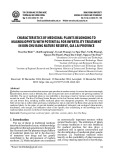
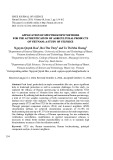
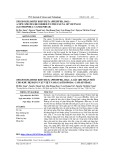
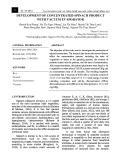
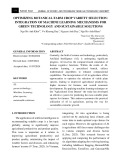
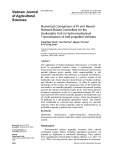
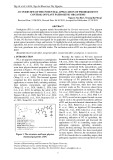
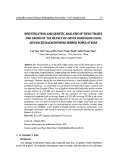
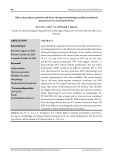
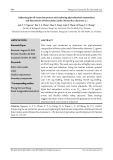





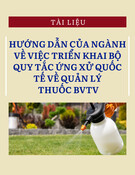
![Tài liệu Quản lý sâu bệnh hại chính trên nhãn, xoài tại Sơn La [mới nhất]](https://cdn.tailieu.vn/images/document/thumbnail/2025/20250908/kimphuong1001/135x160/621757323949.jpg)
![Hướng dẫn an toàn phun thuốc BVTV bằng thiết bị bay không người lái (UAV/Drone) tại Việt Nam [Tài liệu]](https://cdn.tailieu.vn/images/document/thumbnail/2025/20250908/kimphuong1001/135x160/9771757324045.jpg)
